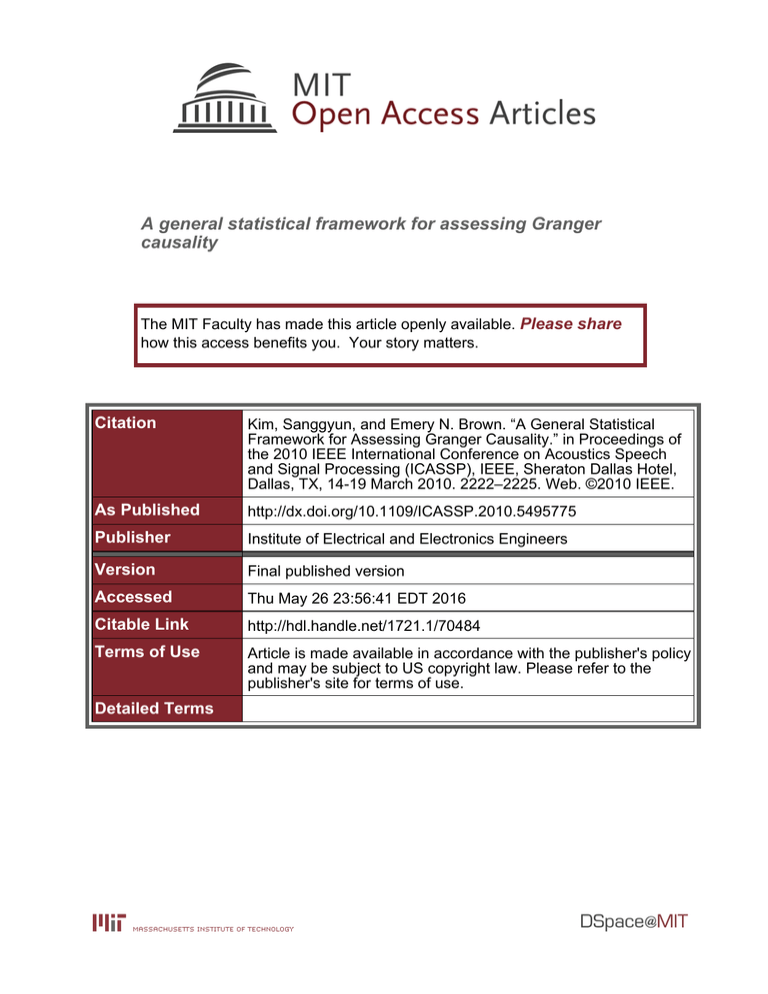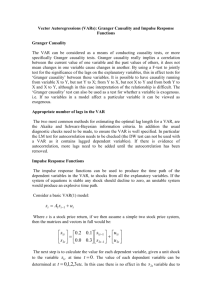A general statistical framework for assessing Granger causality Please share
advertisement

A general statistical framework for assessing Granger
causality
The MIT Faculty has made this article openly available. Please share
how this access benefits you. Your story matters.
Citation
Kim, Sanggyun, and Emery N. Brown. “A General Statistical
Framework for Assessing Granger Causality.” in Proceedings of
the 2010 IEEE International Conference on Acoustics Speech
and Signal Processing (ICASSP), IEEE, Sheraton Dallas Hotel,
Dallas, TX, 14-19 March 2010. 2222–2225. Web. ©2010 IEEE.
As Published
http://dx.doi.org/10.1109/ICASSP.2010.5495775
Publisher
Institute of Electrical and Electronics Engineers
Version
Final published version
Accessed
Thu May 26 23:56:41 EDT 2016
Citable Link
http://hdl.handle.net/1721.1/70484
Terms of Use
Article is made available in accordance with the publisher's policy
and may be subject to US copyright law. Please refer to the
publisher's site for terms of use.
Detailed Terms
A GENERAL STATISTICAL FRAMEWORK FOR ASSESSING GRANGER CAUSALITY
Sanggyun Kim1 and Emery N. Brown1,2,3
Department of BCS, 2 Harvard-MIT Division of HST, MIT, Cambridge, MA 02139, USA
3
Neuroscience Statistics Research Lab, MGH, Harvard Medical School, Boston, MA 02114, USA
{sgkim,enb}@neurostat.mit.edu
1
ABSTRACT
Assessing the causal relationship among multivariate time series is a crucial problem in many fields. Granger causality has
been widely used to identify the causal interactions between
continuous-valued time series based on multivariate autoregressive models in the Gaussian case. In order to extend the
application of the Granger causality concept to non-Gaussian
time series, we propose a general statistical framework for
assessing the causal interactions. In this study, the Granger
causality from a time series x2 to a time series x1 is assessed
based on the relative reduction of the likelihood of x1 by the
exclusion of x2 compared to the likelihood obtained using all
the time series. Simulation results indicated that the proposed
algorithm accurately predicted nature of interactions between
discrete-valued time series as well as between continuousvalued time series.
Index Terms— Granger causality, generalized linear
model, false discovery rate, neural spike train data
1. INTRODUCTION
Identifying causal interactions between time series is a crucial
problem in many fields such as economics, social science,
and physics. Recently in neuroscience the ability to exploit
causal relationships, as opposed to just correlation, is also becoming more important to the understanding of cooperative
nature of neural computation [1], [2]. The basic idea of the
causality between two time series was introduced by Wiener
[3] but was too general to implement practically. Granger formalized this idea in order to enable practical implementation
based on the multivariate autoregressive (MVAR) models [4]:
if the variance of the prediction error of a time series x1 (t)
is reduced by the inclusion of the past values of a time series x2 (t), then x2 is said to cause x1 in a ‘Granger’ sense.
In the case of more than two time series, causal relationship
between any two of the series may be indirect, i.e., mediated
by another time series, and this issue was addressed by the
technique called conditional Granger causality [5].
This work was supported by NIH Grants DP1-OD003646 and R01EB006385.
978-1-4244-4296-6/10/$25.00 ©2010 IEEE
2222
Linear Granger causality (LGC) based on the MVAR
models, combined with an implicit Gaussianity assumption
on the time series, provides a widely used framework for
testing causality between continuous-valued time series [5],
[6]. However, it is applicable only to Gaussian time series,
but inapplicable to non-Gaussian case such as discrete-valued
time series.
To address this issue, we propose a general statistical
framework for assessing the causal relationships. When the
probability of a time series at the current time is modeled
using the past values of itself and other time series, we assess
the Granger causality based on the likelihood ratio test [6].
That is, we assess the Granger causality from a time series x2
to x1 by calculating the relative reduction of the likelihood
of x1 by the exclusion of x2 compared with the likelihood
obtained using all the time series. If the likelihood ratio is
less than one, there is causal influence from x2 to x1 , and if
the ratio is one, there is no causality. The Granger causality
measure based on the likelihood ratio test is exactly reduced
to the LGC measure in the Gaussian case [6]. The likelihood
ratio test statistic also enables us to perform several statistical
significance tests such as the chi-squared test, the Z-test, and
the F-test, which investigate the original causal connectivity
between multiple time series. When assessing the causality
relationships between multiple time series, we use the false
discovery rate (FDR) to correct for multiple hypothesis testing [8]. We also show how the dependence measure between
two time series x1 and x2 can be decomposed based on the
proposed measure.
Simulation results demonstrate that the proposed framework estimated the underlying causal connectivity more exactly rather than the LGC for discrete-valued and mixture
model case.
2. PROBABILISTIC GRANGER CAUSALITY
Consider K multivariate time series {xk (t)}K
k=1 for 0 ≤ t ≤
T . Let us denote the past values of a time series xk (t) at time
t as xk (t) = {xk (s), s < t}, the past values of all time series at time t as a column vector x(t) = [x1 (t), ..., xK (t)]T ,
and the past values obtained after excluding xj (t) from x(t)
ICASSP 2010
as xj (t), respectively. Let us assume that xi is not caused by
xj , i.e., xj has no direct influence on xi or indirect influence
that is mediated by other time series. In this case, xi (t) is
conditionally independent of xj (t) given all the past values
that have direct influences on xi (t) [7]. This can be mathematically represented as
p(xi (t)|x(t)) = p(xi (t)|xj (t)).
(1)
When the left-hand side of the equation (1) is greater than the
right-hand side, xj is said to cause xi .
Based on this property, we assess the Granger causality
using the log-likelihood ratio. From (1), the likelihood function of time series xi is represented as
Li (θ i |xi ) =
0
T
p(xi (t)|x(t); θ i )dt
(2)
where the parameter vector θ i includes information about the
dependency of xi (t) on x(t). Henceforth, we will denote
Li (θ i |xi ) as Li (θ i ) for simplicity. Using the likelihood of
(2), the Granger causality from xj to xi is assessed as
Γij = log
Li (θ ji )
Li (θ i )
(3)
where the likelihood Li (θ ji ) is calculated using xj (t) instead
of x(t) of (2) in order to remove the effect of xj on xi and
the parameter vector θ ji for xj (t). If xj causes xi in the
Granger sense, the likelihood Li (θ i ) is greater than the likelihood Li (θ ji ), i.e., Γij < 0. In contrast, if xj does not cause
xi , the likelihood ratio of (3) is equal to one, i.e., Γij = 0.
3. SIGNIFICANCE TEST
The Granger causality measure of (3) represents the relative
strength of causal interactions among time series but provides
little insight into the original connectivity among them. To
investigate the original causal connectivity, our study introduces statistical significance test based on the log-likelihood
ratio statistic.
The significance test is based on the goodness-of-fit
(GOF) statistics [9]. Consider the null hypothesis given
as H0 : θ 0 = θ ji . An alternative hypothesis is given as
H1 : θ 1 = θ i . These two models are nested since a model for
θ ji is a special case of the more general model for θ i . We can
test H0 against H1 using the test statistic S, which is given
by −2Γij . If these models describe the data well, then the
test statistic S will be asymptotically chi-squared, which is
described simply as S ∼ χ2M where the degree of freedom
M is the difference in dimensionality of two models [9].
If the value of the test statistic S is consistent with χ2M
distribution, H0 is accepted since it is simpler. This result
2223
indicates that xj (t) contains no significant information that
would assist in predicting xi (t). Thus, xj has no causal influence on xi . On the contrary, if the value of S is in the critical
region, i.e., greater than the upper tail 100 × (1 − α)% of
the distribution, then H0 may be rejected in favor of H1 since
the model of H1 describes the data with significantly more
accuracy. This indicates that xj (t) contains information that
improves the ability to predict xi (t). Thus xj causes xi in the
Granger sense. In this work, α was set to 0.05.
When the generalized linear model (GLM) framework is
used to model the distribution of times series, we can use the
deviance as the GOF statistic [10]. The deviance difference
between two models is given by ΔD = −2Γij , which is
used as the GOF statistic. However, for the Gaussian distribution the deviance depends on the variance of the distribution,
which is usually unknown in practice. In this case in order to
remove the variance term the ratio S = ΔD/D1 where D1 is
the deviance obtained based on θ 1 is used as the test statistic,
which can be now calculated from the data. If H0 is correct,
S follows the central F-distribution, F (M, N − p) where N
is the number of observations and p is the dimensionality of
θ1 .
When assessing the causal interactions between multiple
time series, we should consider a family of hypothesis inferences simultaneously; however, multiple hypothesis tests are
more likely to incorrectly reject the null hypothesis [11]. In
our study, we control the expected proportion of incorrectly
rejected null hypotheses (type I errors) by exploiting the FDR
[8].
4. DECOMPOSITION OF DEPENDENCE MEASURE
In our study, we show how the dependence measure between
two time series can be decomposed based on the Granger
causality measure based on the likelihood ratio statistic. Symmetrically to (3), the Granger causality measure from xi to xj
is obtained as
Γji = log
Lj (θ ij )
.
Lj (θ j )
(4)
In addition to two unidirectional Granger causality measures,
we can consider another causality measure called instantaneous causality, which may be caused by an exogenous common input or a low temporal resolution of data. The instantaneous causality measure between xi and xj is defined as
Γi·j = log
Li (θ i )Lj (θ j )
Lij (θ ij )
(5)
where Lij (θ ij ) is the joint likelihood function of xi and xj .
If Γi·j = 0, then xi and xj instantaneously cause one another.
If xi and xj are independent of one another, the joint density function can be decomposed into the product of marginal
Γi,j = log
Li (θ ji )Lj (θ ij )
Lij (θ ij )
.
(6)
Using the definitions cited above, we obtained
Γi,j = Γij + Γji + Γi·j .
(7)
5. SIMULATIONS
In this paper, we used the GLM framework to model the distribution of time series [10]. In a GLM framework, each time
series is assumed to be generated from a particular distribution function in the exponential family, which allows us to
model count data by Poisson, binomial, and multinomial distributions as well as skewed data by Gamma distributions. We
analyzed the Granger causality in the GLM framework based
on an assumption that the mean of each time series depends
on its own history and the past values of concurrent time series as
(8)
where E[xi (t)] is the expected value of xi (t) and gi is the link
function [10].
The proposed framework was compared to the LGC for
the mixture model of continuous- and discrete-valued time
series and for the binary model such as spike train data.
Prior to performing simulations, a model for each time
series was selected. We fitted several models with different
model order to each time series and then identified the best
approximating model from among a set of candidates using
Akaike’s information criterion (AIC) [12].
5.1. Gaussian case
As mentioned previously, when the distribution of time series is assumed to be Gaussian, the Granger causality measure
based on the likelihood ratio statistic is equivalent to the LGC
[6]; The log-likelihood ratio of (3) is reduced to the difference
of the variances of prediction errors.
5.2. Mixture model
We analyzed the Granger causality for the mixture model of
both continuous- and discrete-valued time series. For analysis, based on the causality network of Fig. 1 (a) generated
2224
3URSRVHG
(a)
Therefore, the total dependence between two time series xi
and xj is decomposed into three measures: two unidirectional
Granger causality measures between xi and xj and one nondirectional instantaneous causality measure between them.
E[xi (t)] = μi (t|x(t)) = gi−1 (x(t)T θ i )
(IIHFWV
/*&
density functions of xi and xj . So we can define the measure
of dependence between xi and xj as
&DXVHV
(b)
&DXVHV
(c)
Fig. 1. (a) Three time series interact one another based on
the shown network. (b) The LGC failed to estimate the original network. (c) The connectivity pattern estimated by the
proposed framework exactly matched the original one of (a).
were 15,000 samples of x1 and x3 of Gamma distribution and
x2 of Poisson distribution, whose means depended on the past
values through the link function of each distribution as (8),
which are given by
1/μ1 (t|x(t)) = 1 + 0.5x1 (t − 1) + x2 (t − 1) + 0.5x3 (t − 2),
log μ2 (t|x(t)) = 1 + x1 (t − 2),
(9)
1/μ3 (t|x(t)) = 2 + 0.5x3 (t − 1).
We partitioned the generated data into three complementary subsets and used the first 5,000 samples for the training
and the remaining 10,000 samples for the testing. The estimated causality networks using both algorithms are shown
in Fig. 1 (b) and (c); White circle represents causal relationship from ‘Cause’ to ‘Effect’. As shown in Fig. 1 (b) the
LGC failed to estimate the original causal interactions; however, the proposed predicted nature of interactions between
data with a high accuracy as shown in Fig. 1 (c).
5.3. Neural spike train data
In this paper, we assessed the Granger causality between synthetically generated spike train data using the proposed framework, combined with a point process statistics. The discrete,
all-or-nothing nature of a sequence of spike train together
with their statistical structures suggests that a neural spike
train data can be regarded as a point process [13]. To model
the effect of its own and other time series past values, the logarithm of the conditional intensity function, λ(t|x(t)), which
completely characterizes a point process, is expressed as a linear combination of the past values. This is similar to a Poisson
case of the GLM. Three spike train data were generated based
on the three-neuron network of Fig. 2 (a). The firing probability of each neuron is modulated by a self-inhibitory (black)
interactions in addition to the inhibitory (black) and excitatory (white) interactions. The parameter vectors for the selfinhibitory, inhibitory, and excitatory interactions are given by
[-1 -0.5], [-0.5 -1], and [0.5 1], respectively. Each neuron
had a spontaneous firing rate of 15 Hz, and the time resolution was 1 ms. An absolute refractory period of 1 ms was
(IIHFWV
(a)
real data we usually don’t know the ground truth, thus we
used simulated data to evaluate the performance of the proposed framework in this work. In future investigations, the
proposed framework will be applied to assess the causality
between real data such as recorded neural spike train data.
3URSRVHG
/*&
&DXVHV
&DXVHV
(b)
(c)
7. REFERENCES
Fig. 2. (a) Three-neuron network. Each neuron was selfinhibitory. Neurons interact through inhibitory (black) and
excitatory (white) connections. (b) The LGC failed to identify the original causal network. (c) The proposed framework
predicted the original network with high accuracy.
enforced to prevent neurons from firing a spike in adjacent
time steps. According to the above settings, 300,000 samples
were generated, and the first 100,000 samples were used for
training and the remaining samples used for testing.
Using the generated spike train data, we inferred the underlying causal interactions. In case of the LGC, lowpass
filtering as a preprocessing step was performed to transform
spike train data into continuous-valued data [2]. The inhibitory and the excitatory interactions were distinguished by
the sign of the estimated parameters. The obtained results
are shown in Fig. 2 (b) and (c), respectively. As shown, the
causality pattern estimated by only the proposed framework
exactly matched the original network of Fig. 2 (a).
6. DISCUSSION
Here we propose a probabilistic framework for assessing
Granger causality between time series based on the loglikelihood ratio statistic. A Granger causality measure is
proposed based on the log-likelihood ratio and a significance
test to identify the original connectivity. The FDR is used to
correct for multiple hypothesis testings. We show that using
the Granger causality measure based on the likelihood ratio
statistic the dependence measure can be decomposed into
three measures. Geweke also showed the decomposition of
the dependence measure in Gaussian case [6], but our study
outlines a more general decomposition of the dependence
measure for any distributions.
In this paper, we use the GLM framework to model time
series, which can model a variety of distributions, and we
show that the the proposed measure is reduced to the LGC in
the Gaussian case. Besides the GLM, we can also use other
distributions to assess the Granger causality between time series, and the key point is how to model the dependency of
xi (t) on x(t) to fit time series well.
Simulation results showed that the proposed accurately
predicted nature of interactions between discrete-valued time
series as well as between continuous-valued time series. For
2225
[1] Brovelli et al., “Beta oscillations in a large-scale sensorimotor cortical network: directional influences revealed
by Granger causality,” Proc. Natl. Acad. Sci. USA, vol.
101, pp. 9849–9854, 2004.
[2] Kaminski et al., “Evaluating causal relations in neural
systems: Granger causality, directed transfer function
and statistical assessment of significance,” Biol. Cybern., vol. 85, pp. 145–157, 2001.
[3] N. Wiener, The theory of prediction. In: E. F. Beckenbach (Ed) Modern Mathematics for Engineers,
McGraw-Hill, New York, 1956.
[4] C. Granger, “Investigating causal relations by econometric models and cross-spectral methods,” Econometrica, vol. 37, pp. 424–438, 1969.
[5] J. Geweke, “Measures of conditional linear dependence
and feedback between time series,” J. Am. Stat. Assoc.,
vol. 79, pp. 907–915, 1984.
[6] J. Geweke, “Measurement of linear dependence and
feedback between multiple time series,” J. Am. Stat. Assoc., vol. 77, pp. 304–313, 1982.
[7] C. Granger, “Some recent developments in a concept of
causality,” J. Econometrics, vol. 39, pp. 199–211, 1988.
[8] Y. Benjamini and Y. Hochberg, “Controlling the false
recovery rate: a practical and powerful approach to multiple testing,” J. Roy. Stat. Soc., vol. 57, pp. 289–300,
1995.
[9] Y. Pawitan, In all likelihood: Statistical modeling and
inference using likelihood, New York: Oxford University Press, 2001.
[10] P. McCullagh and J. Nelder, Generalized linear models,
Chapman and Hall/CRC, 1989.
[11] R. G. Miller,
Simultaneous statistical inference,
Springer Verlag New York, 1981.
[12] H. Akaike, “A new look at the statistical model identification,” IEEE Transactions on Automatic Control, vol.
19, pp. 716–723, 1974.
[13] E. N. Brown, Theory of point processes for neural systems, In: Methods and Models in Neurophysics: Elsevier, 2005.







